Here you can find Who invented-discovered what on the specific month days!
Data is available in per date basis & in both languages English & ગુજરાતી
April Month
Today’s temperature:-31℃
Sunrise:-6:33 am
Sunset:-6:57 pm
Length of the day:-12h 23m
William Harvey (1st April 1578):-
He w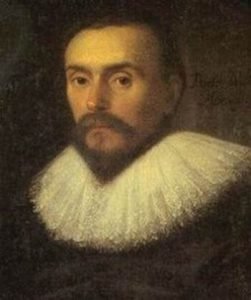 as a physician who worked in the field of anatomy and physiology. He was the first to explain the function of the heart and the transfer of blood to the body. He stated that the artery and vein together form the transport system. The transport system begins with the heart. A large amount of blood is transported through the arteries to the tissues and is returned to the heart by blood vessels from different parts of the body. Thus, the blood completes such a cycle from the heart to the whole body and from there to the heart again. The blood stream flows throughout the body due to contraction of the heart. He also wrote the book ‘de motu cordis’, a blood transfusion book that was in Latin and published in 1628.
as a physician who worked in the field of anatomy and physiology. He was the first to explain the function of the heart and the transfer of blood to the body. He stated that the artery and vein together form the transport system. The transport system begins with the heart. A large amount of blood is transported through the arteries to the tissues and is returned to the heart by blood vessels from different parts of the body. Thus, the blood completes such a cycle from the heart to the whole body and from there to the heart again. The blood stream flows throughout the body due to contraction of the heart. He also wrote the book ‘de motu cordis’, a blood transfusion book that was in Latin and published in 1628.
વિલિયમ હાર્વે (૧ એપ્રિલ ૧૫૭૮):-
તેઓ ફિઝિશિયન હતા જેમણે એનાટોમી અને ફિઝિયોલોજી ક્ષેત્રે કાર્ય કર્યું હતું. હૃદયનું કાર્ય અને શરીરમાં રુધિરનું પરિવહન સમજાવનાર તેઓ પ્રથમ વ્યક્તિ હતા. તેમણે જણાવ્યું કે ધમની અને શીરા ભેગા મળીને પરિવહન તંત્રની રચના કરે છે. પરિવહન તંત્રની શરૂઆત હૃદયથી થાય છે. મોટા પ્રમાણમાં રુધીરનો જથ્થો પેશીઓ તરફ ધમની મારફતે વહન પામે છે અને શરીરનાં વિવિધ ભાગોમાંથી રુધિર શિરા દ્વારા હૃદયમાં પાછું આવે છે. આમ, રુધિર હૃદયથી આખા શરીરમાં અને ત્યાંથી ફરી વખત હૃદયમાં આવી ચક્ર પૂર્ણ કરે છે. આ રુધીરનો પ્રવાહ આખા શરીરમાં હૃદયનાં સંકોચનનાં કારણે વહન પામે છે. તેમણે રુધિરનું પરિવહન સમજાવતું પુસ્તક ‘de motu cordis’ પણ લખ્યું હતું જે લેટિન ભાષામાં હતું અને 1628માં પ્રખ્યાત થયું હતું.
Today’s temperature:-31℃
Sunrise:-6:33 am
Sunset:-6:57 pm
Length of the day:-12h 23m
Jacques Francis Albert Pierre Miller
(2nd April 1931):-
French-Australian physician who, in 1962, demonstrated the importance of the thymus gland in organizing the immunity of animals. If the thymus gland is removed at a sufficiently early stage, a young animal is unable to develop antibody resistance to foreign molecules. Thus, the thymus, located high in the chest, is essential for the immune response. This is because the thymus makes T lymphocytes or T cells (T = thymus) from the stem cells which migrate into the organ from bone marrow. This T-cells protects from foreign particles.
જેક ફ્રાન્સિસ આલ્બર્ટ મિલર (૨ એપ્રિલ ૧૯૩૧):-
ફ્રેન્ચ-ઑસ્ટ્રેલિયન ચિકિત્સક હતાં જેમણે, 1962માં, પ્રાણીઓની રોગપ્રતિકારક શક્તિ માટે થાઇમસ ગ્રંથિનું મહત્વ સમજાવ્યું હતું. જો થાઇમસ ગ્રંથિને પ્રારંભિક તબક્કે દૂર કરવામાં આવે, તો નાનો, નવો સજીવ ફોરેન મોલોક્યુલ્સ સામે પ્રતિકાર કરતાં એન્ટિબોડી વિકસાવી શકતો નથી. આમ, થાઇમસ કે જે છાતીનાં ભાગમાં સ્થિત છે, રોગપ્રતિકારક પ્રતિક્રિયા માટે જરૂરી છે. કારણ કે થાઇમસ ગ્રંથિ સ્ટેમ સેલ્સમાંથી T- લિમ્ફોસાઇટ્સ અથવા T- સેલ્સ (T = થાઇમસ) બનાવે છે જે અસ્થિ મજ્જામાંથી અંગમાં સ્થળાંતર કરે છે. આ T-સેલ શરીરમાં આવતા ફોરેન પાર્ટીકલ સામે રક્ષણ કરે છે.
Today’s temperature:-32℃
Sunrise:-6:32 am
Sunset:-6:57 pm
Length of the day:-12h 24m
 Katherine Esau (3rd April 1898):-
Katherine Esau (3rd April 1898):-
Russian-born American botanist who did groundbreaking work in the structure and workings of plants. She is best known for her research into the effects of viruses upon plant tissues, and her studies of plant tissue structures and physiology. Her research into plant viruses focused on how viruses effect the structure and development of a plant’s phloem (its food-conducting tissue). In addition, she clarified the development phases of plant tissues, particularly the sieve tubes which serve to move solutes throughout a plant.
કેથરિન ઈસૌ (૩ એપ્રિલ ૧૮૯૮):-
રશિયન-મૂળના અમેરિકન વનસ્પતિશાસ્ત્રી, જેમણે છોડના બંધારણ અને કાર્ય ઉપર કામ કર્યું. તે વનસ્પતિ પેશીઓ પર વાયરસની અસરો અને છોડના પેશીઓના બંધારણ અને તેના અભ્યાસ ઉપર સંશોધન માટે વધુ જાણીતી છે. વનસ્પતિમાં વાયરસ અંગેના તેમના સંશોધનમાં તે છોડના અન્નવાહક (તેના ખોરાકને લગતી પેશીઓ) ની રચના અને વિકાસ પર કેવી અસર પડે છે તેના પર ધ્યાન કેન્દ્રિત કર્યું છે. આ ઉપરાંત, તેણે છોડના પેશીઓના વિકાસના તબક્કાઓ, ખાસ કરીને નલિકાઓ જે છોડમાં દ્રવ્યો પસાર કરે છે તેના વિશે સ્પષ્ટતા કરી.
Today’s temperature:-33℃
Sunrise:-6:31 am
Sunset:-6:57pm
Length of the day:-12h 25m

Ananda Chakrabarty (4th April 1938):-
Indian-American biochemist who is most notable for his work in directed evolution and his role in developing a genetically (genetically modified) organisms using plasmid transfer while working at General electric company. He developed new species of Pseudomonas bacteria (“the oil-eating bacteria”) in 1971. The genes necessary to degrade oil were carried on plasmids, which could be transferred among species. By irradiating the transformed organism with UV light after plasmid transfer, Prof. Chakrabarty discovered a method for genetic cross-linking that fixed all four plasmid genes in place and produced a new, stable, bacterial species (now called Pseudomonas putida).
આનંદા ચક્રબર્તી (૪ એપ્રિલ ૧૯૩૮):-
ભારતીય-અમેરિકન બાયોકેમિસ્ટ કે જેમણે જનરલ ઇલેક્ટ્રિક કંપનીમાં કામ કરતી વખતે પ્લાઝ્મિડ ટ્રાન્સફરનો ઉપયોગ કરીને આનુવંશિક રીતે મોડિફાઇડ સજીવો વિકસાવ્યા હતાં અને તેમના આ કામ માટે તેઓ જાણીતા હતાં. તેમણે 1971 માં સ્યુડોમોનાસ બેક્ટેરિયાની નવી પ્રજાતિઓ (“તેલ ખાનારા બેક્ટેરિયા”) વિકસાવી હતી. તેલને ડિગ્રેડ કરવા માટે જરૂરી જનીનો પ્લાઝ્મિડમાં આવેલા હતાં, જે અલગ અલગ પ્રજાતિઓમાં અલગ અલગ હોય છે. પ્લાઝમિડ ટ્રાન્સફર પછી UV લાઇટમાંથી નવા સજીવને પસાર કરીને, પ્રો. ચક્રબર્તીએ આનુવંશિક ક્રોસ લિન્કિંગ માટેની એક પદ્ધતિ શોધી કાઢી જેમાં ચારેય પ્લાઝમિડ જનીનને ભેગા કરી અને નવી, બેક્ટેરિયલ પ્રજાતિ (જેને હવે સ્યુડોમોનાસ પુટિડા કહે છે) ઉત્પન્ન કરી.
Today’s temperature:-31℃
Sunrise:-6:30 am
Sunset:-6:57 pm
Length of the day:-12h 26m
 Clarence E. McClung (5th April 1870):-
Clarence E. McClung (5th April 1870):-
Clarence Erwin McClung was an American geneticist and paleontologist who discovered the role of chromosomes in sex determination in a species of grasshopper. He reported that sperm exist in two forms, each with a different chromosome configuration. Thus, he was one of the first (1901) to deduce that chromosomes determine the sex of offspring. McClung also studied how the behaviour of chromosomes in the sex cells of different organisms affects their heredity. His theory was one of many that inspired scientists to pursue investigations such as the Human Genome Project, an attempt to map the structure and location of all human genes.
ક્લેરેન્સ ઇ. મેકક્લંગ (૫ એપ્રિલ ૧૮૭૦):-
ક્લેરેન્સ એર્વિન મકક્લંગ એક અમેરિકન જિનેટિસ્ટ અને પેલેઓંટોલોજિસ્ટ હતા જેમણે ખડમાકડી (ગ્રાસહૉપર)માં જાતિ નક્કી કરવામાં રંગસૂત્રોની ભુમિકા શોધી હતી. તેમણે જણાવ્યું કે શુક્રાણુ બે સ્વરૂપોમાં અસ્તિત્વ ધરાવે છે, પ્રત્યેકમાં રંગસૂત્ર અલગ છે. આમ, રંગસૂત્રો સંતાનનું લિંગ નક્કી કરે છે તે નક્કી કરવા માટે તે દર્શાવવામાં તેઓ પ્રથમ (1901) હતો. મેકક્લંગે એ પણ અભ્યાસ કર્યો કે વિવિધ સજીવોના જાતીય કોષોમાં રંગસૂત્રોની વર્તણૂક તેમના આનુવંશિકતાને કેવી રીતે અસર કરે છે. તેમના સિદ્ધાંતોએ વૈજ્ઞાનિકોને હ્યુમન જિનોમ પ્રોજેક્ટ જેવી તપાસ આગળ વધારવા માટે પ્રેરણા આપી હતી, જે તમામ માનવ જનીનોની રચના અને સ્થાનનો નકશો દર્શાવે છે.
Today’s temperature:-30℃
Sunrise:-6:31 am
Sunset:-6:58 pm
Length of the day:-12h 28m
 James Watson (6th April 1928):-
James Watson (6th April 1928):-
James Watson is an American biochemist and geneticist who shared the 1962 Nobel Prize for Physiology or Medicine (with Francis Crick and Maurice Wilkins) for the discovery of “the molecular structure of nucleic acids and its significance for information transfer in living material.” Deoxyribonucleic acid (DNA) is the substance contained in cells that controls heredity. Crick and Watson began their collaboration in 1951, and published their paper on the double helix structure on 2 Apr 1953. This accomplishment became a cornerstone of genetics and was widely regarded as one of the most important discoveries of 20th-century biology.
જેમ્સ વોટ્સન (૬ એપ્રિલ ૧૯૨૮):-
જેમ્સ વોટ્સન એક અમેરિકન બાયોકેમિસ્ટ અને જીનેટિસ્ટ છે જેમણે “ન્યુક્લિક એસિડ્સનાં પરમાણુ બંધારણ અને તેનું સજીવોમાં મહત્વની માહિતીનાં સ્થાનાંતરણ મહત્વ” સમજાવા માટે (ફ્રાન્સિસ ક્રિક અને મૌરિસ વિલ્કિન્સ સાથે) ફિઝિયોલોજી અથવા મેડિસિન માટે 1962નો નોબેલ પુરસ્કાર શેર કર્યો હતો. ડિઓક્સિરીબોન્યુક્લિક એસિડ (DNA) એ કોષોમાં સમાયેલ પદાર્થ છે જે આનુવંશિકતા માટે જવાબદાર છે. ક્રિક અને વોટ્સને 1951માં સહોગમાં કાર્ય કરવાની શરૂઆત કરી, અને 2 એપ્રિલ 1953ના રોજ ડબલ હેલિક્સ રચના ઉપરનાં તેમના લેખ પ્રકાશિત કર્યા. આ સિદ્ધિ આનુવંશિકતાનો પાયાનો ભાગ બની ગઈ અને તેનો સમાવેશ 20મી સદીના જીવવિજ્ઞાનની મહત્વપૂર્ણ શોધોમાં કરવામાં આવે છે.
Today’s temperature:-32℃
Sunrise:-6:29 am
Sunset:-6:58pm
Length of the day:-12h 29m

Kenneth Oakley (7th April 1911):-
Kenneth Page Oakley was an English physical anthropologist, geologist and paleontologist who developed a method to date fossils bones by measuring their fluoride levels, based on a French mineralogist’s theory that bones would gradually absorb fluoride from surrounding soil. A “Piltdown Man” skull had been “unearthed” in 1912, in Piltdown, England, and had for decades been said to represent the “missing link” in human evolution. With his fluoride and other tests he proved the true age of the bones to be a modern human braincase and an orangutan jawbone.
કેનેથ ઓક્લે (૭ એપ્રિલ ૧૯૧૧):-

કેનેથ ઓક્લે એક ઇંગ્લિશ શારીરિક માનવશાસ્ત્રી, ભૂસ્તરશાસ્ત્રી અને પેલેઓંટોલોજિસ્ટ હતા, જેમણે ફ્રેન્ચ માઈનરોલોજીસ્ટના સિદ્ધાંતના મુજબ ફ્લોરાઇડ સ્તર દ્વારા અવશેષો કેટલા વર્ષો જુના છે તે શોધવાની પદ્ધતિ વિકસાવી હતી. હાડકા તેની આસપાસની જમીનમાંથી ધીમે ધીમે ફ્લોરાઇડ ગ્રહણ કરશે અને તેના આધારે તે કેટલા સમય જુના છે તે જાણી શકાય. ઇંગ્લેન્ડના પિલ્ટડાઉનમાં, 1912 માં એક “પિલ્ટડાઉન મેન” ખોપરીને શોધી હતી અને જેને દાયકાઓથી માનવીય ઉત્ક્રાંતિની “ગુમ થયેલ કડી” તરીકે ઓળખવામાં આવે છે. તેના ફ્લોરાઇડ અને અન્ય પરીક્ષણો દ્વારા તેમણે જણાવ્યું કે હાડકાં આધુનિક માનવના મગજ અને જડબાની સાથે મળતા આવતા હતાં.
Today’s temperature:-32℃
Sunrise:-6:28 am
Sunset:-6:59pm
Length of the day:-12h 30m

Harvey Cushing (8th April 1869):-
Harvey Williams Cushing was an American neurosurgeon who was a pioneer of neurosurgery, and studied blood pressure. His clinical contributions are legendary: the use of x-rays in surgical practice, the discovery of the pituitary as the master hormone gland, founding the clinical specialty of endocrinology, the anesthesia record, the use of blood pressure measurement in surgical practice. He performed the first brain surgery in the U.S. on 21 Feb 1902.
હાર્વે કુશિંગ (૮ એપ્રિલ ૧૮૬૯):-
હાર્વે વિલિયમ્સ કુશિંગ એ અમેરિકન ન્યુરોસર્જન હતા, જે ન્યૂરોસર્જરીના પ્રણેતા હતા, અને બ્લડ પ્રેશરનો અભ્યાસ કરનારા પ્રથમ વ્યક્તિ હતા. તેના ક્લિનિકલ ક્ષેત્રે યોગદાન સુપ્રસિદ્ધ છે: જેમ કે સર્જિકલ પ્રેક્ટિસમાં એક્સ-રેનો ઉપયોગ, માસ્ટર હોર્મોન ગ્રંથિ તરીકે પિચ્યુટરી ગ્રંથિની શોધ, અંતઃ સ્ત્રાવી ગ્રંથિની ક્લિનિકલ વિશેષતા, એનેસ્થેસિયા રેકોર્ડ, બ્લડ પ્રેશર પદ્ધતિનો ઉપયોગ સર્જિકલ પ્રેક્ટિસમાં રુધિરનું દબાણ માપવા માટે જેવી શોધો માટે જાણીતા છે. તેમણે 21 ફેબ્રુઆરી, 1902 ના રોજ યુ.એસ. માં પ્રથમ મગજની શસ્ત્રક્રિયા કરી હતી.
Today’s temperature:-32℃
Sunrise:-6:27 am
Sunset:-6:59pm
Length of the day:-12h 32m
Thomas Johann Seebeck (9th April 1770):-
Ger man physicist who discovered (1821) that an electric current flows between different conductive materials that are kept at different temperatures, known as the Seebeck effect. It is the basis of the thermocouple and is considered the most accurate measurement of temperature. It is also a key component of the semi-conductor, the foundation of the modern computer business. Seebeck’s work was the basis of German physicist Georg Simon Ohm (1789-1854) discoveries in electricity and of French physicist Jean Charles Athanase Peltier (1785-1845), whose Peltier effect became well known as a way to use electricity to freeze water (air conditioning, refrigeration).
man physicist who discovered (1821) that an electric current flows between different conductive materials that are kept at different temperatures, known as the Seebeck effect. It is the basis of the thermocouple and is considered the most accurate measurement of temperature. It is also a key component of the semi-conductor, the foundation of the modern computer business. Seebeck’s work was the basis of German physicist Georg Simon Ohm (1789-1854) discoveries in electricity and of French physicist Jean Charles Athanase Peltier (1785-1845), whose Peltier effect became well known as a way to use electricity to freeze water (air conditioning, refrigeration).
થોમસ જોહ્ન સીબેક (૯ એપ્રિલ ૧૭૭૦):-
જર્મન ભૌતિકશાસ્ત્રી જેમણે શોધ્યું(1821) કે વિદ્યુત પ્રવાહ જુદા જુદા તાપમાને રાખવામાં આવેલા જુદા જુદા વાહક પદાર્થો વચ્ચે વહે છે જેને સીબેક અસર તરીકે ઓળખવામાં આવે છે. તેનો આધાર થર્મોકપલ નામનાં યંત્ર ઉપર રહેલો છે જે તાપમાન માપવા માટેનું સૌથી સચોટ યંત્ર છે. તે સેમી-કંડક્ટરનો એક મુખ્ય ઘટક છે, જે આધુનિક કમ્પ્યુટર વ્યવસાયનો મુખ્ય ભાગ છે. સીબેકનું કાર્ય, જર્મન ભૌતિકશાસ્ત્રી જ્યોર્જ સિમોન ઓહમ (1789-1854)ની વિદ્યુતની શોધ અને ફ્રેન્ચ ભૌતિકશાસ્ત્રી જીન ચાર્લ્સ અથનીસ પેલ્ટીઅર (1785-1845) ની શોધ પેલ્ટીઅર અસર માટે આધાર હતો.પેલ્ટીઅર અસર કે જેમાં પાણીને થીજવવા માટે વીજળીનો ઉપયોગ (એર-કન્ડિશનિંગ, રેફ્રિજીરેશન) કરવામાં આવે છે.
Today’s temperature:-31℃
Sunrise:-6:26 am
Sunset:-6:59 pm
Length of the day:-12h 33m
Marshall Nirenberg (10th April 1927):-

Marshall Warren Nirenberg was an American biochemist who shared with (Robert William Holley and Har Gobind Khorana) the 1968 Nobel Prize for Physiology or Medicine. He was noted for his role in deciphering the genetic code. He demonstrated that, with the exception of “nonsense codons,” each possible triplet (called a codon) of four different kinds of nitrogen-containing bases found in deoxyribonucleic acid (DNA) and, in some viruses, in ribonucleic acid (RNA) ultimately causes the incorporation of a specific amino acid into a cell protein.
માર્શલ નિરેનબર્ગ (૧૦ એપ્રિલ ૧૯૨૭):-
માર્શલ વોર્નર નિરેનબર્ગ એ અમેરિકન બાયોકેમિસ્ટ હતાં જેમણે (રોબર્ટ વિલિયમ હોલી અને હર ગોવિંદ ખુરાના સાથે) 1968માં ફિઝિયોલોજી અથવા મેડિસિન માટેનું નોબેલ પુરસ્કાર મેળવ્યું હતું. તેઓ આનુવંશિક કોડને ઉકેલવામાં તેમની ભૂમિકા માટે જાણીતા હતાં. તેમણે દર્શાવ્યું કે, “નોનસેન્સ કોડોન”નાં અપવાદ સિવાય, અલગ અલગ ચાર નાઇટ્રોજન બેઝનાં બનેલા દરેક શક્ય ટ્રીપ્લેટ (જેને કોડન કહેવામાં આવે છે), જે ડિઓક્સિરીબોન્યુક્લીક એસિડ (DNA) માં જોવા મળે છે, અને કેટલાક વાયરસમાં, રિબોન્યુક્લીક એસિડ (RNA) માં, કોષીય પ્રોટીનમાં ચોક્કસ એમિનો એસિડનો સમાવેશ કરે છે.
Today’s temperature:-31℃
Sunrise:-6:25 am
Sunset:-7:00 pm
Length of the day:-12h 34m
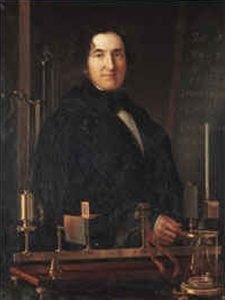 Macedonio Melloni (11th April 1798):-
Macedonio Melloni (11th April 1798):-
Italian physicist who was the first to extensively research Infrared radiation. Sir William Frederick Herschel discovered infrared radiation in 1800, but research stalled until the invention of a thermopile in 1830. That instrument was a series of strips of two different metals that produced electric current when one end was heated. Melloni improved the thermopile and used it to detect infrared radiation. He showed that rock salt, being transparent to infrared, made suitable lenses and prisms to demonstrate the reflection, refraction and polarization of infrared in the same manner as visible light.
મેસેડોનીયો મેલોની (૧૧ એપ્રિલ ૧૭૯૮):-
તેઓ ઈટાલિયન ભૌતિકશાસ્ત્રી હતાં કે જેમણે સૌપ્રથમ ઈન્ફ્રારેડ રેડિયેશન ઉપર વિસ્તૃત સંશોધન કર્યું હતું. સર વિલિયમ ફ્રેડરિક હર્શેલ એ 1800 માં ઈન્ફ્રારેડ રેડિયેશનની શોધ કરી હતી, પરંતુ 1830માં થર્મોપાઈલની શોધ થાય ત્યાં સુધી સંશોધન અટકી ગયું. આ સાધન બે અલગ અલગ ધાતુઓની પટ્ટીઓની ધરાવતું હતું જે એક છેડે ગરમ થાય ત્યારે ઇલેક્ટ્રિક પ્રવાહ ઉત્પન્ન કરતી હતી. મેલોનીએ થર્મોપાઇલમાં સુધારો કર્યો અને તેનો ઉપયોગ ઇન્ફ્રારેડ રેડિયેશન શોધવા માટે કર્યો. તેમણે જણાવ્યું કે રોક સોલ્ટ (મીઠાનાં પથ્થર), ઈન્ફ્રારેડ માટે પારદર્શક હોવાથી, તેમાંથી દૃશ્યમાન પ્રકાશની જેમ જ ઈન્ફ્રારેડનાં પ્રતિબિંબ, રીફ્રેક્શન અને ધ્રુવીકરણ દર્શાવવા માટે યોગ્ય લેન્સ અને પ્રિઝમ બનાવી શકાય છે.
Today’s temperature:-33℃
Sunrise:-6:24 am
Sunset:-7:00 pm
Length of the day:-12h 35m
 Sir James Mackenzie (12th April 1853):-
Sir James Mackenzie (12th April 1853):-
Scottish cardiologist, pioneer in the study of cardiac arrhythmias. He was first to make simultaneous records of the arterial and venous pulses to evaluate the condition of the heart. Mackenzie also drew attention to the question of the heart’s capacity for work. His work was particularly important in distinguishing atrial fibrillation and in treating this common condition with digitalis. In 1892, he built a machine for detecting and recording physiological activity, such as pulse rate and blood pressure, since known as a polygraph, and later used as a lie detector.
સર જેમ્સ મેકેન્ઝી (૧૨ એપ્રિલ ૧૮૫૩):-
તેઓ સ્કોટિશ કાર્ડિયોલોજિસ્ટ હતાં, કાર્ડિયાક એરિથમિયાનાં (અતાલબદ્ધતાનાં) અધ્યયન ક્ષેત્રે કાર્ય કરનારા પ્રથમ વ્યક્તિ  હતાં. તેમણે હૃદયની સ્થિતિનું મૂલ્યાંકન કરવા માટે ધમની અને શીરાનાં ધબકારાનો એક સાથે રેકોર્ડ બનાવ્યો. મેકેન્ઝીએ હૃદયની કાર્યક્ષમતાનાં પ્રશ્ન તરફ પણ ધ્યાન દોર્યું. તેમનું કાર્ય ધમનીનાં ફાઇબ્રિલેશનને(રચનાને)અલગ પાડવામાં અને ડિજિટલિસ દ્વારા આ સ્થિતિની સારવારમાં મહત્વપૂર્ણ હતું. 1892 માં, તેણે પોલિગ્રાફ નામનું પલ્સ રેટ અને બ્લડ પ્રેશર જેવી શારીરિક પ્રવૃત્તિ માપવા અને રેકોર્ડ કરવા માટે એક મશીન બનાવ્યું, અને જે હાલમાં લાય ડિટેક્ટર (ખોટું જાણવા માટે વપરાતું યંત્ર) તરીકે ઓળખાય છે.
હતાં. તેમણે હૃદયની સ્થિતિનું મૂલ્યાંકન કરવા માટે ધમની અને શીરાનાં ધબકારાનો એક સાથે રેકોર્ડ બનાવ્યો. મેકેન્ઝીએ હૃદયની કાર્યક્ષમતાનાં પ્રશ્ન તરફ પણ ધ્યાન દોર્યું. તેમનું કાર્ય ધમનીનાં ફાઇબ્રિલેશનને(રચનાને)અલગ પાડવામાં અને ડિજિટલિસ દ્વારા આ સ્થિતિની સારવારમાં મહત્વપૂર્ણ હતું. 1892 માં, તેણે પોલિગ્રાફ નામનું પલ્સ રેટ અને બ્લડ પ્રેશર જેવી શારીરિક પ્રવૃત્તિ માપવા અને રેકોર્ડ કરવા માટે એક મશીન બનાવ્યું, અને જે હાલમાં લાય ડિટેક્ટર (ખોટું જાણવા માટે વપરાતું યંત્ર) તરીકે ઓળખાય છે.
Today’s temperature:-36℃
Sunrise:-6:24 am
Sunset:-7:00 pm
Length of the day:-12h 36m
Bruno Rossi (13th April 1905):-
Bruno Benedetto Rossi was an Italian-A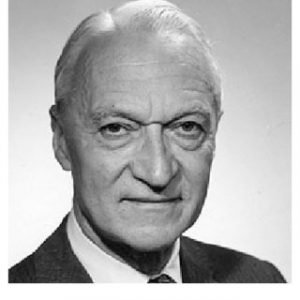 merican physicist who was a pioneer in the study of cosmic radiation. In the 1930s, his experimental investigations of cosmic rays and their interactions with matter laid the foundation for high energy particle physics. Cosmic rays are atomic particles that enter earth’s atmosphere from outer space at speeds approaching that of light. He was one of the first to use rockets to study cosmic rays above the Earth’s atmosphere. Finding X-rays from space he became the grandfather of high energy astrophysics, being largely responsible for starting X-ray astronomy, as well as the study of interplanetary plasma.
merican physicist who was a pioneer in the study of cosmic radiation. In the 1930s, his experimental investigations of cosmic rays and their interactions with matter laid the foundation for high energy particle physics. Cosmic rays are atomic particles that enter earth’s atmosphere from outer space at speeds approaching that of light. He was one of the first to use rockets to study cosmic rays above the Earth’s atmosphere. Finding X-rays from space he became the grandfather of high energy astrophysics, being largely responsible for starting X-ray astronomy, as well as the study of interplanetary plasma.
બ્રુનો રોસી (૧૩ એપ્રિલ ૧૯૦૫):-
બ્રુનો રોસી ઈટાલિયન-અમેરિકન ભૌતિકશાસ્ત્રી હતાં, જે કોસ્મિક રેડિયેશનનાં અધ્યયનનાં પ્રણેતા હતાં. 1930ના દાયકામાં, કોસ્મિક કિરણોની તેમની પ્રાયોગિક તપાસ અને દ્રવ્ય સાથેની તેમની ક્રિયા-પ્રતિક્રિયાએ ઉચ્ચ ઉર્જાવાળા કણોનાં ભૌતિકશાસ્ત્રનો પાયો નાખ્યો. કોસ્મિક કિરણો એ આણ્વીયકણો છે જે પ્રકાશની જેટલી ગતિથી બાહ્ય અવકાશમાંથી પૃથ્વીનાં વાતાવરણમાં પ્રવેશ કરે છે. તેઓ પૃથ્વીનાં વાતાવરણની ઉપરનાં કોસ્મિક કિરણોનાં અભ્યાસ માટે રોકેટોનો ઉપયોગ કરનારા પ્રથમ વ્યક્તિ હતાં. અવકાશમાંથી એક્સ-રે શોધ્યા બાદ તેઓ ઉચ્ચ ઉર્જાનાં એસ્ટ્રોફિઝિક્સનાં ગ્રેન્ડફાધર તરીકે પ્રખ્યાત થયાં, આ ઉપરાંત તેઓ મોટા પ્રમાણમાં એક્સ-રે ઉપર કાર્ય કરવા માટે, તેમજ આંતર-ગ્રહીય પ્લાઝમાનાં અભ્યાસ માટે પણ જાણીતા છે.
Today’s temperature:-37℃
Sunrise:-6:23 am
Sunset:-7:01 pm
Length of the day:-12h 38m
Famous day:- Ambedkar jayanti
Birthday of Bhimrao Ramji Ambedkar (Bhabhasaheb Ambedkar). He was independent India’s first law and justice minister.
Christiaan Huygens (14th April 1629):-
Dutch physicist, mathematician, astronomer and inventor, who is widely regarded as one of the greatest scientists of all time and a major figure in the scientific revolution. In physics, Huygens made groundbreaking contributions in optics and mechanics, while as an astronomer he is chiefly known for his studies of the rings of Saturn and the discovery of its moon Titan. As an inventor, he improved the design of the telescope with the invention of the Huygenian 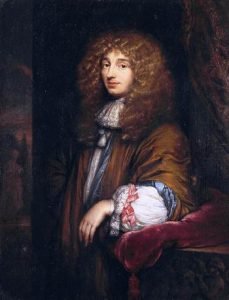 eyepiece. His most famous invention, however, was the pendulum clock in 1656, which was a breakthrough in timekeeping and became the most accurate timekeeper for almost 300 years. Because he was the first to use mathematical formulae to describe the laws of physics, Huygens has been called the first theoretical physicist and the founder of mathematical physics.
eyepiece. His most famous invention, however, was the pendulum clock in 1656, which was a breakthrough in timekeeping and became the most accurate timekeeper for almost 300 years. Because he was the first to use mathematical formulae to describe the laws of physics, Huygens has been called the first theoretical physicist and the founder of mathematical physics.
ક્રિસ્ટિઆન હ્યુજેન્સ (૧૪ એપ્રિલ ૧૬૨૯):-

ડચ ભૌતિકશાસ્ત્રી, ગણિતશાસ્ત્રી, ખગોળશાસ્ત્રી અને શોધક, જે સર્વકાલિન મહાન વૈજ્ઞાનિકો પૈકી એક અને વૈજ્ઞાનિક ક્રાંતિના મુખ્ય વ્યક્તિ તરીકે ગણવામાં આવે છે. ભૌતિકશાસ્ત્રમાં, હ્યુજેન્સે ઓપ્ટિક્સ અને મિકેનિક્સમાં ઘણું યોગદાન આપ્યું હતું, જ્યારે એક ખગોળશાસ્ત્રી તરીકે તેઓએ શનિ ગ્રહ ફરતે આવેલી રિંગ અને તેના ચંદ્ર (ઉપગ્રહ) ટાઇટનની શોધ માટે જાણીતા છે. શોધક તરીકે, તેમણે હ્યુજેનિયન આઈપિસની શોધ સાથે ટેલિસ્કોપની રચનામાં સુધારો કર્યો. તેમ છતાં, તેની સૌથી પ્રખ્યાત શોધ, 1656 માં લોલક ઘડિયાળ હતી, જે સમય જાણવામાં એક પ્રગતિ હતી અને લગભગ 300 વર્ષ સુધીનો સૌથી સચોટ સમય જણાવતી હતી. ભૌતિકશાસ્ત્રનાં નિયમોનું વર્ણન કરવા માટે ગાણિતિક સૂત્રોનો ઉપયોગ કરનારા તેઓ પ્રથમ વ્યક્તિ હતાં, હ્યુજેન્સને પ્રથમ સૈદ્ધાંતિક ભૌતિકશાસ્ત્રી અને ગાણિતિક ભૌતિકશાસ્ત્રનાં સ્થાપક કહેવામાં આવે છે.
Today’s temperature:-36℃
Sunrise:-6:22 am
Sunset:-7:01 pm
Length of the day:-12h 39m
Samuel K. Hoffman (15th April 1902):-
Samuel Kurtz Hoffman was an American engineer who led the development of the liquid fuel rocket engines used in America’s early space programs. His career began as an aeronautical-design engineer (1932-45) and then he spent four years teaching in that field. By 1949, he joined the Propulsion Section of North American Aviation which he later headed as its president (1960-70). He supervised the development of the first-stage Redstone propulsion system, which launched Explorer I, America’s first satellite (31 Jan 1958). His work continued with the high-thrust engines used for the Mercury rockets that propelled the first U.S. astronauts into space.
સે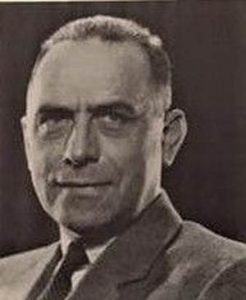 મ્યુઅલ કે. હોફમેન (૧૫ એપ્રિલ ૧૯૦૨):-
મ્યુઅલ કે. હોફમેન (૧૫ એપ્રિલ ૧૯૦૨):-
સેમ્યુઅલ કર્ટઝ હોફમેન એક અમેરિકન એન્જિનિયર હતો જેમણે અમેરિકાનાં પ્રારંભિક અવકાશ કાર્યક્રમોમાં રોકેટ એન્જિનોમાં પ્રવાહી બળતણનાં ઉપયોગની શરૂઆત કરી હતી. તેમની કારકિર્દીની શરૂઆત એરોનોટિકલ-ડિઝાઇન એન્જિનિયર(1932-45) તરીકે કરી હતી અને ત્યારબાદ તેમણે તે ક્ષેત્રમાં ચાર વર્ષ ભણાવવામાં પસાર કર્યા હતાં. 1949 સુધીમાં, તેઓ નોર્થ અમેરિકન એવિએશનનાં પ્રોપલ્શન સેક્શનમાં જોડાયા, જે પછીથી તેમણે તેના પ્રમુખનું (1960-70) પદ મેળવ્યું. તેમણે પ્રથમ તબક્કાનાં રેડસ્ટોન પ્રોપલ્શન સિસ્ટમનાં વિકાસનું કાર્ય કર્યું હતું, જેના દ્વારા અમેરિકાનાં પ્રથમ ઉપગ્રહ (31 જાન્યુઆરી 1958) એક્સપ્લોરર I ને લૉન્ચ કરવામાં આવ્યો હતો. તેમણે બુધ રોકેટ માટે ઉપયોગમાં લેવામાં આવતા ઉચ્ચ-થ્રસ્ટ એન્જિનો ઉપર પણ કાર્ય કર્યું હતું જેના દ્વારા પ્રથમ યુ.એસ. અવકાશયાત્રી અવકાશમાં ગયો હતો.
Today’s temperature:-36℃
Sunrise:-6:22 am
Sunset:-7:01 pm
Length of the day:-12h 39m
John Hadley (16th April 1682):-
He was an English mathematician, and laid claim to the invention of the octant. In 1730 Hadley invented the reflecting octant, which could be used to measure the altitude of the s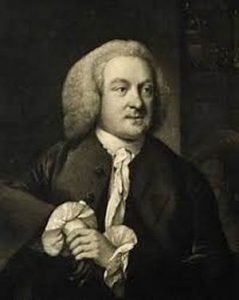 un or other celestial objects above the horizon at sea. A mobile arm carrying a mirror and pivoting on a graduated arc provides a reflected image of the celestial body overlapping the image of the horizon, which is observed directly.If the position of the object on the sky and the time of the observation are known, it is easy for the user to calculate his own latitude. The octant proved extremely valuable for navigation and displaced the use of other instruments such as the Davis quadrant. Hadley also developed ways to make objective mirrors for reflecting telescopes. In 1721 he showed the first parabolic Newtonian telescope to the Royal Society. He also made Gregorian telescopes with accurately shaped mirrors.
un or other celestial objects above the horizon at sea. A mobile arm carrying a mirror and pivoting on a graduated arc provides a reflected image of the celestial body overlapping the image of the horizon, which is observed directly.If the position of the object on the sky and the time of the observation are known, it is easy for the user to calculate his own latitude. The octant proved extremely valuable for navigation and displaced the use of other instruments such as the Davis quadrant. Hadley also developed ways to make objective mirrors for reflecting telescopes. In 1721 he showed the first parabolic Newtonian telescope to the Royal Society. He also made Gregorian telescopes with accurately shaped mirrors.
જ્હોન હાડલી (૧૬ એપ્રિલ ૧૬૮૨):-
તેઓ એક અંગ્રેજી ગણિતશાસ્ત્રી હતાં, અને ઓક્ટેન્ટની શોધ કરી હતી. 1730 માં હાડલીએ પ્રતિબિંબિ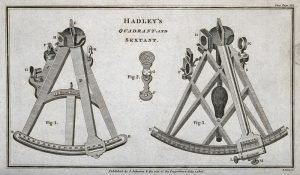 ત ઓક્ટેન્ટની શોધ કરી, જેનો ઉપયોગ સૂર્યની ઉંચાઇ અથવા સમુદ્ર સપાટીથી ક્ષિતિજ ઉપરનાં અન્ય અવકાશી પદાર્થોને માપવા માટે થઈ શકે છે. અરીસાને લઈને અને ધરીને આકાશ તરફ રાખી અવકાશી પદાર્થનું પ્રતિબિંબ લેવામાં આવે, જેનું અવલોકન કરવામાં આવે છે. જો આકાશ પરની વસ્તુની સ્થિતિ અને નિરીક્ષણનો સમય જાણી શકાય, તો તેના અક્ષાંશની ગણતરી કરવી સરળ બની જાય છે. અષ્ટકોર્ષ સંશોધક માટે ખૂબ જ મૂલ્યવાન સાબિત થયો અને ડેવિસ ચતુર્થાંશ જેવા અન્ય સાધનોનાં સ્થાને તે વધુ ઉપયોગી સાબિત થયું. હાડલીએ ટેલિસ્કોપ્સમાં વધુ સારા પ્રતિબિંબ માટે ચોક્કસ અરીસાઓ બનાવવાની રીતો પણ વિકસાવી. 1721 માં તેમણે રોયલ સોસાયટીને પ્રથમ પેરાબોલિક ન્યુટોનિયન ટેલિસ્કોપ બતાવ્યું, તેમજ તેમણે ચોક્કસ આકારના અરીસાઓ સાથેનું ગ્રેગોરીયન ટેલિસ્કોપ્સ પણ બનાવ્યું હતું.
ત ઓક્ટેન્ટની શોધ કરી, જેનો ઉપયોગ સૂર્યની ઉંચાઇ અથવા સમુદ્ર સપાટીથી ક્ષિતિજ ઉપરનાં અન્ય અવકાશી પદાર્થોને માપવા માટે થઈ શકે છે. અરીસાને લઈને અને ધરીને આકાશ તરફ રાખી અવકાશી પદાર્થનું પ્રતિબિંબ લેવામાં આવે, જેનું અવલોકન કરવામાં આવે છે. જો આકાશ પરની વસ્તુની સ્થિતિ અને નિરીક્ષણનો સમય જાણી શકાય, તો તેના અક્ષાંશની ગણતરી કરવી સરળ બની જાય છે. અષ્ટકોર્ષ સંશોધક માટે ખૂબ જ મૂલ્યવાન સાબિત થયો અને ડેવિસ ચતુર્થાંશ જેવા અન્ય સાધનોનાં સ્થાને તે વધુ ઉપયોગી સાબિત થયું. હાડલીએ ટેલિસ્કોપ્સમાં વધુ સારા પ્રતિબિંબ માટે ચોક્કસ અરીસાઓ બનાવવાની રીતો પણ વિકસાવી. 1721 માં તેમણે રોયલ સોસાયટીને પ્રથમ પેરાબોલિક ન્યુટોનિયન ટેલિસ્કોપ બતાવ્યું, તેમજ તેમણે ચોક્કસ આકારના અરીસાઓ સાથેનું ગ્રેગોરીયન ટેલિસ્કોપ્સ પણ બનાવ્યું હતું.
Today’s temperature:-33℃
Sunrise:-6:20 am
Sunset:-7:02 pm
Length of the day:-12h 41m

Augustus Edward Hough Love (17th April 1863):-
British geophysicist and mathematician who discovered a major type of earthquake wave that was subsequently named for him. Love assumed that the Earth consists of concentric layers that differ in density and postulated the occurrence of a seismic wave confined to the surface layer (crust) of the Earth which propagated between the crust and underlying mantle. His prediction was confirmed by recordings of the behaviour of waves in the surface layer of the Earth. He proposed a method, based on measurements of Love waves, to measure the thickness of the Earth’s crust. In addition to his work on geophysical theory, Love studied elasticity and wrote A Treatise on the Mathematical Theory of Elasticity, 2 vol. (1892-93).
ઓગસ્ટસ એડવર્ડ હોફ લવ (૧૭ એપ્રિલ ૧૮૬૩):-
બ્રિટિશ ભૂ-ભૌતિકશાસ્ત્રી અને ગણિતશાસ્ત્રી કે જેમણે ભૂકંપનાં મુખ્ય પ્રકારનાં તરંગો શોધ્યા હતાં જેનું પછીથી નામ તેમના નામ પરથી રાખવામાં આવ્યું છે. લવએ ધાર્યું કે પૃથ્વીનાં કેન્દ્રમાં અલગ અલગ સ્તરોનો સમાવેશ થાય છે જેની ઘનતા ભિન્ન હોય છે અને ધરતીના સપાટીના સ્તર (પોપડા) સુધી મર્યાદિત સિસ્મિક તરંગો મોકલે છે જે સપાટીનાં સ્તર અને અંતર્ગત આવરણ વચ્ચે પ્રસરે છે. તેમની વાત પૃથ્વીની સપાટીના સ્તરમાં તરંગોનાં રેકોર્ડિંગ દ્વારા સાચી સાબિત થઈ. તેમણે પૃથ્વીના પોપડાની જાડાઈને માપવા માટે લવ તરંગોનાં માપનનાં આધારેની રીત આપી. જીઓફિઝિકલ સિદ્ધાંત પરનાં તેમના કાર્ય ઉપરાંત, લવએ સ્થિતિસ્થાપકતાનો અભ્યાસ કર્યો અને મેથેમેટિકલ થિયરી ઓફ ઇલાસ્ટીસિટીનાં બીજા ભાગ (1892-93) ઉપર લેખ લખ્યો.
Today’s temperature:-36℃
Sunrise:-6:19 am
Sunset:-7:02 pm
Length of the day:-12h 42m
H.L.Calle ndar (18th April 1863):-
ndar (18th April 1863):-
Hugh Longbourne Callendar was an English physicist who was famous for work in calorimetry, thermometry and especially, the thermodynamic properties of steam. He published the first steam tables (1915). In 1886, he invented the platinum resistance thermometer using the electrical resistivity of platinum, enabling the precise measurement of temperatures. He also invented the electrical continuous-flow calorimeter, the compensated air thermometer (1891), a radio balance (1910) and a rolling-chart thermometer (1897) that enabled long-duration collection of climatic temperature data. His son, Guy S. Callendar linked climatic change with increases in carbon dioxide (CO2) resulting from mankind’s burning of carbon fuels (1938), known as the Callendar effect, part of the greenhouse effect.
એચ.એલ. કેલેન્ડર (૧૮ એપ્રિલ ૧૮૬૩):-
હ્યુ લોંગબોર્ન કેલેન્ડર એક ઇંગ્લિશ ભૌતિકશાસ્ત્રી હતાં, જે કોલોરીમેટ્રી, થર્મોમેટ્રી અને ખાસ કરીને સ્ટીમ (વરાળનાં) થર્મોડાયનેમિક ગુણધર્મો ઉપર કામ માટે પ્રખ્યાત હતાં. તેમણે પ્રથમ સ્ટીમ ટેબલ(1915) પ્રકાશિત કર્યું હતું. 1886માં, તેમણે પ્લેટિનમની વિદ્યુત પ્રતિકારકતાનો ઉપયોગ કરીને પ્લેટિનમ રેઝિસ્ટન્સ થર્મોમીટરની શોધ કરી, આ થર્મોમીટર તાપમાનનાં ચોક્કસ માપન કરવા માટે ઉપયોગી હતાં. આ ઉપરાંત તેમણે સતત ઇલેક્ટ્રિકલ પ્રવાહ વહી શકે તેવા કોલોરીમીટર, એર થર્મોમીટર (1891), રેડિયો બેલેન્સ (1910) અને રોલિંગ-ચાર્ટ થર્મોમીટર (1897) જે આબોહવાનાં લાંબા ગાળાનાં તાપમાનનાં ડેટાનો સંગ્રહ કરી શકતું હતું તેની શોધ પણ કરી હતી. તેમના પુત્ર, ગાય એસ. કેલેન્ડેરે, મનુષ્યનાં કાર્બનયુક્ત ઇંધણ (1938)નાં ઉપયોગથી ઉત્પન્ન થતાં કાર્બન ડાયોક્સાઇડ (CO2) નો વધારો અને તેની આબોહવા ઉપર થતી અસર વિશે જણાવ્યું હતું. જેને ક્લેન્ડર અસર તરીકે ઓળખવામાં આવે છે, જે ગ્રીનહાઉસ ઇફેક્ટનાં ભાગ તરીકે ઓળખાય છે.
Today’s temperature:-36℃
Sunrise:-6:19 am
Sunset:-7:03 pm
Length of the day:-12h 44m
Famous day:- On this day in 1975, ISRO built India’s first satellite, Aryabhata, which was launched by the Soviet Union.
Glenn Sea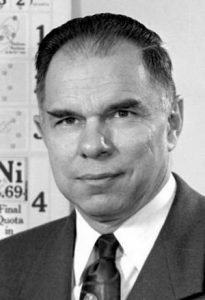 borg (19th April 1912):-
borg (19th April 1912):-
American nuclear chemist. During 1940-58, Seaborg and his colleagues at the University of California, produced nine of the transuranic elements (plutonium to nobelium) by bombarding uranium and other elements with nuclei in a cyclotron. He coined the term actinide for the elements in this series. The work on elements was directly relevant to the WW II effort to develop an atomic bomb. It is said that he was influential in determining the choice of plutonium rather than uranium in the first atomic-bomb experiments. Seaborg and his early collaborator Edwin McMillan shared the 1951 Nobel Prize for chemistry. Seaborg was chairman of the US Atomic Energy Commission 1962-71. Element 106, seaborgium (1974), was named in his honour.
ગ્લેન સીબર્ગ (૧૯ એપ્રિલ ૧૯૧૨):-
તેઓ અમેરિકન પરમાણુ રસાયણશાસ્ત્રી હતાં. 1940-58 દરમિયાન, યુનિવર્સિટી ઓફ કેલિફોર્નિયામાં, સીબર્ગ અને તેના સાથીઓએ સાયક્લોટ્રોનમાં યુરેનિયમ અને બીજા તત્વોનાં બોમ્બ ધડાકા દ્વારા નવ ટ્રાન્સયુરેનિક (યુરેનિયમ કરતાં વધુ ઉંચી અણુસંખ્યા વાળા) તત્વો (પ્લુટોનિયમથી નોબેલિયમ) બનાવ્યા. તેમણે આ શ્રેણીનાં તત્વો માટે એક્ટિનાઇડ શબ્દ આપ્યો. તત્વો પરનું કાર્ય એ બીજા વિશ્વયુદ્ધમાં અણુબોમ્બ વિકસાવવા સાથે સંકળાયેલું હતું. એવું કહેવામાં આવે છે કે તે પહેલા અણુ-બોમ્બ પ્રયોગોમાં યુરેનિયમની જગ્યાએ પ્લુટોનિયમનો ઉપયોગ કરવામાં આવ્યો હતો. સીબર્ગ અને તેમના સહયોગી એડવિન મેકમિલેને 1951માં રસાયણશાસ્ત્ર માટેનો નોબેલ પુરસ્કાર શેર કર્યો હતો. સીબર્ગ 1962-71 દરમ્યાન યુ.એસ.નાં અણુઉર્જા પંચનાં અધ્યક્ષ હતાં. રસાયણશાસ્ત્રમાં 106 નંબરનાં તત્વનું નામ સીબોર્જિયમ (1974), તેમના નામ ઉપરથી આપવામાં આવ્યું છે.
Today’s temperature:-36℃
Sunrise:-6:18 am
Sunset:-7:03 pm
Length of the day:-12h 45m
Karl Alexander Muller (20th April 1927):-
Karl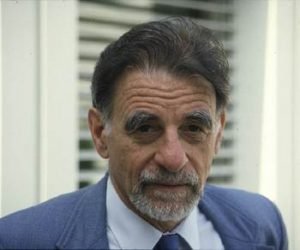 Alexander Müller is a Swiss physicist and Nobel laureate. He received the Nobel Prize in Physics in 1987 with Georg Bednorz for their work in superconductivity in ceramic materials. He worked on the Hall Effect in gray tin, a semimetal. At IBM (International Business Machines Corporation) his research for almost 15 years centered on SrTiO3 (strontium titanate). He studied their photochromic properties, their chemical binding, ferroelectric and soft-mode properties. In the early 1980s, Müller began searching for substances that would become superconductive at higher temperatures. The highest critical temperature (Tc) attainable at that time was about 23 K. In 1983 Müller recruited Georg Bednorz to IBM, to help systematically test various oxides. In 1986 the two succeeded in achieving superconductivity in lanthanum barium copper oxide (LBCO) at a temperature of 35 K. This discovery stimulated a great deal of additional research in high-temperature superconductivity.
Alexander Müller is a Swiss physicist and Nobel laureate. He received the Nobel Prize in Physics in 1987 with Georg Bednorz for their work in superconductivity in ceramic materials. He worked on the Hall Effect in gray tin, a semimetal. At IBM (International Business Machines Corporation) his research for almost 15 years centered on SrTiO3 (strontium titanate). He studied their photochromic properties, their chemical binding, ferroelectric and soft-mode properties. In the early 1980s, Müller began searching for substances that would become superconductive at higher temperatures. The highest critical temperature (Tc) attainable at that time was about 23 K. In 1983 Müller recruited Georg Bednorz to IBM, to help systematically test various oxides. In 1986 the two succeeded in achieving superconductivity in lanthanum barium copper oxide (LBCO) at a temperature of 35 K. This discovery stimulated a great deal of additional research in high-temperature superconductivity.
કાર્લ એલેક્ઝાંડર મુલર (૨૦ એપ્રિલ ૧૯૨૭):-
કાર્લ મુલર એક સ્વિસ ભૌતિકશાસ્ત્રી અને નોબેલ વિજેતા છે. સિરામિક પદાર્થોમાં સુપરકોન્ડક્ટિવિટીના કામ માટે 1987 માં જ્યોર્જ બેડનોર્ઝ સાથે તેમને ભૌતિકશાસ્ત્રનું નોબેલ પુરસ્કાર આપવામાં આવ્યો હતો. તેમણે ગ્રે ટીનમાં હોલ ઇફેક્ટ પર કામ કર્યું, જે એક અર્ધધાતુ છે. IBM (ઇન્ટરનેશનલ બિઝનેસ મશીન કોર્પોરેશન) ખાતે તેમણે લગભગ 15 વર્ષ સુધી SrTiO3 (સ્ટ્રોન્ટીયમ ટાઇટેનેટ) ઉપર સંશોધન કર્યું હતું. તેમણે તેના ફોટોક્રોમિક ગુણધર્મોનો અભ્યાસ કર્યો તેમજ તેમના રાસાયણિક બંધ, ફેરોઇલેક્ટ્રિક અને સોફ્ટ-મોડ ગુણધર્મો ઉપર અભ્યાસ કર્યો હતો. 1980 ના દાયકાની શરૂઆતમાં, મુલરે એવા પદાર્થોની શોધ શરૂ કરી જે ઉચ્ચ તાપમાનમાં સુપરકન્ડક્ટિવ બને. તે સમયે પ્રાપ્ત થયેલું સૌથી વધુ તાપમાન (ટીસી) લગભગ 23 કે. હતું. 1983 માં મુલરે જ્યોર્જ બેડનોર્ઝને IBMમાં ભરતી કરી, જેથી વિવિધ ઓક્સાઇડ્સનાં પદ્ધતિસર પરીક્ષણ કરવામાં મદદ મળી શકે. 1986 માં બંનેએ 35 કે.ના તાપમાને લેન્થેનમ બેરીયમ કોપર ઓકસાઈડ (LBCA) માં સુપરકન્ડક્ટિવિટી પ્રાપ્ત કરવામાં સફળતા મેળવી હતી. આ શોધએ ઉચ્ચ તાપમાનની સુપરકન્ડક્ટિવિટીમાં વધારાના સંશોધનને વેગ આપ્યો હતો.
Today’s temperature:-33℃
Sunrise:-6:17 am
Sunset:-7:03 pm
Length of the day:-12h 46m
Oscar Hertwig (21st April 1849):-
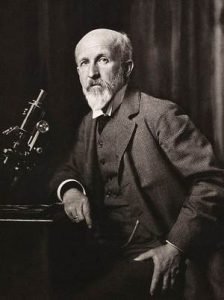
Oskar (Wilhelm August) Hertwig was a German embryologist and cytologist who did extensive work on the nuclear transmission of heredity. He was the first to recognize that the essential event in fertilization is the fusion of the nuclei of the sperm and ovum. In 1875, he observed all the steps in fertilization, including the union of egg and sperm chromosomes in sea urchins. These animals are particularly suitable for microscopic studies because of their transparency. He saw there was a single nucleus before fertilization and two nuclei immediately afterwards. He realized the second nucleus had come from the spermatazoon, and thus a single spermatazoon can fertilize an egg. He also investigated malformations of vertebrate embryos.
ઓસ્કાર હર્ટવિગ (૨૧ એપ્રિલ ૧૮૪૯):-
ઓસ્કાર (વિલ્હેમ ઓગસ્ટ) હર્ટવિગ એક જર્મન એમ્બ્રોયોલોજિસ્ટ અને સાયટોલોજિસ્ટ (કોષવિજ્ઞાની) હતાં જેમણે આનુવંશિકતા માટે કોષકેન્દ્રનાં ટ્રાન્સમિશન પર વિસ્તૃત કાર્ય કર્યું હતું. તેમણે પ્રથમ વખત જણાવ્યું કે ગર્ભ બનવા માટે આવશ્યક ઘટના એ શુક્રાણુ અને અંડકોષનાં કોષકેન્દ્ર અને કોષકેન્દ્રિકાનું મિલન છે. 1875 માં, તેમણે ગર્ભા બનવાનાં તમામ પગલાંનું અવલોકન કર્યું, જેમાં ઇંડા અને શુક્રાણુ રંગસૂત્રો સમુદ્રઅર્ચીન નામનાં પ્રાણીમાં જોડાતા હતા. આ પ્રાણીઓ તેમની પારદર્શકતાનાં કારણે માઇક્રોસ્કોપિક અભ્યાસ માટે વધુ યોગ્ય છે. તેમણે જોયું કે ગર્ભાધાન પહેલાં એક જ કોષકેન્દ્ર હતું અને તે પછી તરત જ બે કોષકેન્દ્ર બની ગયા. તેને સમજાયું કે બીજું કોષકેન્દ્ર શુક્રાણુમાંથી આવ્યું છે, અને આમ એક જ શુક્રાણુ અંડકોષને ફળદ્રુપ કરી શકે છે. તેમણે મેરુદંડી (કરોડરજ્જુવાળા) ભ્રૂણમાં પણ તેની ખોડખાપણનો અભ્યાસ કર્યો હતો.
Today’s temperature:-35℃
Sunrise:-6:16 am
Sunset:-7:04 pm
Length of the day:-12h 47m
Famous day:- World Earth Day
Jean Poiseuille (22nd April 1797):-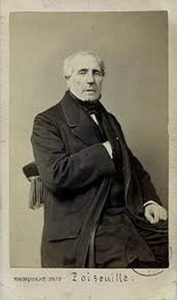
French physician and physiologist who contributed to knowledge of blood circulation through arteries and experimentally derived an equation describing the laminar flow rate of fluids through narrow tubes (now known as the Hagen- Poiseuille equation because the German engineer Gotthilf Hagen also independently discovered it). It relates the flow rate to the fluid’s viscosity, the pressure drop along the tube, and the radius of the tube. His interest in the circulation of the blood led him to conduct experiments on the flow of liquids in narrow tubes. Poiseuille is believed to be the first to have used the mercury manometer to measure blood pressure with his invention, the hemodynamometer, an improved method for measuring blood pressure
જીન પોઇઝ્યુએલ 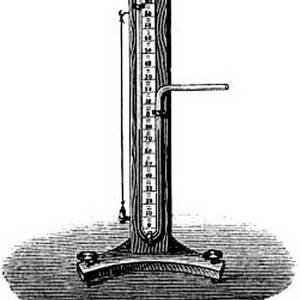 (૨૨ એપ્રિલ ૧૭૯૭):-
(૨૨ એપ્રિલ ૧૭૯૭):-
તેઓ ફ્રેન્ચ ચિકિત્સક અને ફિઝિયોલોજીસ્ટ હતાં જેમણે ધમનીઓ દ્વારા રક્ત પરિભ્રમણને સમજૂતી આપવામાં ફાળો આપ્યો હતો અને પ્રાયોગિક રૂપે સાંકડી નલિકાઓ દ્વારા પ્રવાહી(લોહી) કઈ રીતે લેમિનર પ્રવાહ દ્વારા વહે છે તેનું વર્ણન કરતું એક સમીકરણ મેળવ્યું હતું (હવે હેગન-પોઇઝ્યુએલ સમીકરણ તરીકે ઓળખાય છે, કારણ કે જર્મન વૈજ્ઞાનિક ગોથિલ્ફ હેગને પણ તેને સ્વતંત્ર રીતે શોધ્યું હતું). આ પ્રવાહી(લોહી)નો દર તેની સ્નિગ્ધતા, પ્રવાહી(લોહી)નું નલિકા ઉપર દબાણ અને નલિકાની ત્રિજ્યા સાથે સંબંધિત છે. લોહીના પરિભ્રમણમાં તેની રુચિને લીધે તેમણે સાંકડી નલિકાઓમાં પ્રવાહીનાં(લોહીનાં) વહન પર પ્રયોગો કર્યા. એવું કહેવામાં આવે છે કે પોઇઝ્યુએલએ બ્લડ પ્રેશર માપવા માટે મર્ક્યુરી (પારો) મેનોમીટરનો ઉપયોગ કરનારા પ્રથમ વ્યક્તિ હતા. હેમોડાયનામીમીટરએ બ્લડ પ્રેશર માપવા માટેની એક સુધારેલી પદ્ધતિ છે.
Today’s temperature:-38℃
Sunrise:-6:15 am
Sunset:-7:04 pm
Length of the day:-12h 48m
Max Karl Planck (23rd April 1858):-
He 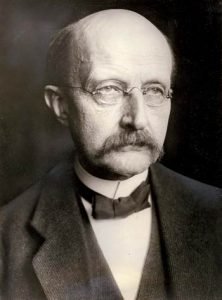 was a German theoretical physicist whose discovery of energy quanta won him the Nobel Prize in Physics in 1918. Planck made many contributions to theoretical physics, but his fame as a physicist rests primarily on his role as the originator of quantum theory. He studied at Munich and Berlin, where he studied under Helmholtz, Clausius and Kirchhoff and subsequently joined the faculty. He became professor of theoretical physics (1889-1926). His work on the law of thermodynamics and the distribution of radiation from a black body led him to abandon classical Newtonian principles and introduce the quantum theory (1900), for which he was awarded the Nobel Prize for Physics in 1918. He gave many law’s like Wien–Planck law, Planck black-body radiation law and also gave Planck’s constant. in formula E= hv, h is Planck’s constant.
was a German theoretical physicist whose discovery of energy quanta won him the Nobel Prize in Physics in 1918. Planck made many contributions to theoretical physics, but his fame as a physicist rests primarily on his role as the originator of quantum theory. He studied at Munich and Berlin, where he studied under Helmholtz, Clausius and Kirchhoff and subsequently joined the faculty. He became professor of theoretical physics (1889-1926). His work on the law of thermodynamics and the distribution of radiation from a black body led him to abandon classical Newtonian principles and introduce the quantum theory (1900), for which he was awarded the Nobel Prize for Physics in 1918. He gave many law’s like Wien–Planck law, Planck black-body radiation law and also gave Planck’s constant. in formula E= hv, h is Planck’s constant.
મેક્સ કાર્લ પ્લાન્ક (૨૩ એપ્રિલ ૧૮૫૮):-
તે એક જર્મન સૈદ્ધાંતિક (થયોરોટીકલ) ભૌતિકશાસ્ત્રી હતાં, જેમની ઉર્જા ક્વોન્ટાની શોધ માટે તેમને 1918 માં ભૌતિકશાસ્ત્રનો નોબેલ પુરસ્કાર આપવામાં આવ્યો હતો. પ્લાન્કે સૈદ્ધાંતિક(થયોરોટીકલ) ભૌતિકશાસ્ત્રમાં ઘણા યોગદાન આપ્યું હતું, પરંતુ ભૌતિકશાસ્ત્રી તરીકેની તેમની ખ્યાતિ મુખ્યત્વે ક્વોન્ટમ સિદ્ધાંતનાં પ્રણેતા તરીકેની છે. તેમણે મ્યુનિક અને બર્લિન ખાતે અભ્યાસ કર્યો, જ્યાં તેમણે હેલ્મહોલ્ટ્ઝ, ક્લોસિયસ અને કિર્ચહોફ જેવાં વૈજ્ઞાનિકની નીચે અભ્યાસ કર્યો અને ત્યારબાદ તેમની ફેકલ્ટીમાં જોડાયા. તે સૈદ્ધાંતિક ભૌતિકશાસ્ત્રનાં પ્રોફેસર બન્યા (1889-1926). થર્મોોડાયનેમિક્સના કાયદા અને બ્લેક બોડીમાંથી કિરણોત્સર્ગનાં વિતરણ અંગેના તેમના કાર્યને લીધે તે ક્લાસિકલ ન્યુટોનિયન સિદ્ધાંતોનો ત્યાગ કરી ક્વોન્ટમ સિદ્ધાંત (1900) આપ્યો, જેના માટે તેમને 1918 માં ભૌતિકશાસ્ત્ર માટે નોબેલ પુરસ્કાર મળ્યો. તેમણે ઘણા નિયમો આપ્યાં જેવા કે વિએન – પ્લાન્ક નિયમ, પ્લાન્ક બ્લેક બોડી રેડિયેશન નિયમ અને પ્લાન્કનો અચળાંક પણ આપ્યો. E = hv ફોર્મ્યુલામાં h એ પ્લેન્કનો અચળાંક છે.
Today’s temperature:-37℃
Sunrise:-6:15 am
Sunset:-7:04 pm
Length of the day:-12h 49m
Anthony Trollope (24th April 1815):-
English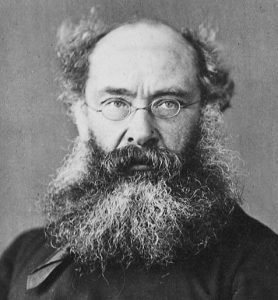 novelist who introduced the familiar red pillar boxes in Britain as street-side receptacles of letters for collection by the Post Office. Trollope was a Surveyor’s Clerk (prior to his fame as a novelist) who was sent in 1851 to inspect the Channel Islands postal services. Postal boxes had previously been used in Belgium and France. Thus, Trollope was not their inventor, but he recommended their use at Jersey’s capital, St. Helier, where there was no receiving office. After approval by the Postmaster- General, the first of four pillar boxes was installed there 23 Nov 1852. The first mainland pillar box appeared the next year in Carlisle, England and the first six in London on 11 Apr 1855.
novelist who introduced the familiar red pillar boxes in Britain as street-side receptacles of letters for collection by the Post Office. Trollope was a Surveyor’s Clerk (prior to his fame as a novelist) who was sent in 1851 to inspect the Channel Islands postal services. Postal boxes had previously been used in Belgium and France. Thus, Trollope was not their inventor, but he recommended their use at Jersey’s capital, St. Helier, where there was no receiving office. After approval by the Postmaster- General, the first of four pillar boxes was installed there 23 Nov 1852. The first mainland pillar box appeared the next year in Carlisle, England and the first six in London on 11 Apr 1855.
એન્થની ટ્રોલોપ (૨૪ એપ્રિલ ૧૮૧૫):-
અંગ્રેજી નવલકથાકાર જેમણે બ્રિટનમાં પરિચિત લાલ બોક્સને પોસ્ટ ઓફિસ દ્વારા પત્રોને સંગ્રહ કરવા માટે રોડની બાજુમાં મુક્યા હતાં. ટ્રોલોપ એક સર્વેયર ક્લાર્ક હતાં (એક નવલકથાકાર તરીકેની તેમની ખ્યાતિ પહેલા) જેને 1851 માં ચેનલ આઇલેન્ડ સેવાઓનું નિરીક્ષણ કરવા મોકલવામાં આવ્યા હતાં. ટપાલ બોક્સનો પહેલાં બેલ્જિયમ અને ફ્રાન્સમાં ઉપયોગ થતો હતો. આમ, ટ્રોલોપ તેના શોધક ન હતાં, પરંતુ તેમણે તેમના ઉપયોગની ભલામણ જર્સીની રાજધાની, સેન્ટ હેલિયરમાં કરી હતી, જ્યાં કોઈ ઓફિસ ન હોતી. પોસ્ટ માસ્તર-જનરલ દ્વારા મંજૂરી બાદ, 23 નવેમ્બર 1852ના રોજ પ્રથમ ચાર બોક્સ મુકવામાં આવ્યા. પ્રથમ પિલર બોક્સ પછીના વર્ષે ઇંગ્લેન્ડના કાર્લિસલમાં અને પ્રથમ છ લંડનમાં 11 એપ્રિલ 1855 ના રોજ મુકવામાં આવ્યા.
Today’s temperature:-36℃
Sunrise:-6:14 am
Sunset:-7:05 pm
Length of the day:-12h 50m
FAMOUS DAY:- WORLD MALARIA DAY
World Malaria Day was established in May 2007. It’s transmitted through the bite of an infected Anopheles mosquito. Infected mosquitoes carry the Plasmodium parasite. When this mosquito bites you, the parasite is released into your bloodstream. On 20 August 1897 Sir Ronald Ross discover this disease. He found the malaria parasite and went on to prove the role of Anopheles mosquitoes in the transmission of malaria parasites in human.
વિશ્વ મેલેરિયા દિવસ
વિશ્વ મેલેરિયા દિવસની સ્થાપના મે 2007 માં કરવામાં આવી હતી. આ ચેપ એનોફિલીસ મચ્છરનાં કરડવાથી ફેલાય છે. ચેપગ્રસ્ત મચ્છરો પ્લાઝમોડિયમ પરોપજીવી ધરાવે છે. જ્યારે આ મચ્છર તમને કરડે છે, ત્યારે પરોપજીવી તમારા લોહીના પ્રવાહમાં મુક્ત થાય છે. 20 ઓગસ્ટ 1897માં સર રોનાલ્ડ રોસએ આ રોગની શોધ કરી હતી. તેમણે મેલેરિયાનાં પરોપજીવીને શોધી કાઢ્યું અને માનવમાં મેલેરિયાનાં પરોપજીવી ફેલાવા માટે એનોફિલીસ મચ્છરની ભૂમિકા સાબિત કરી.
Guglielmo Marconi (25th April 1874):-
Marchese Guglielmo Marconi was an Italian electric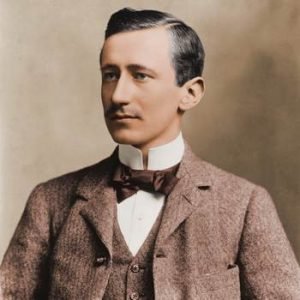 al engineer and inventor who invented the wireless telegraph (1935) known today as radio. In 1894, Marconi began experimenting on the “Hertzian Waves,” the radio waves Heinrich Hertz had first produced in his laboratory a few years earlier. Lacking support from the Italian Ministry of Posts and Telegraphs, Marconi turned to the British Post Office. Marconi obtained the world’s first patent for a system of wireless telegraphy, in 1897, and opened the world’s first radio factory at Chelmsford, England in 1898.
al engineer and inventor who invented the wireless telegraph (1935) known today as radio. In 1894, Marconi began experimenting on the “Hertzian Waves,” the radio waves Heinrich Hertz had first produced in his laboratory a few years earlier. Lacking support from the Italian Ministry of Posts and Telegraphs, Marconi turned to the British Post Office. Marconi obtained the world’s first patent for a system of wireless telegraphy, in 1897, and opened the world’s first radio factory at Chelmsford, England in 1898.
ગુગલીએલ્મો માર્કોની (૨૫ એપ્રિલ ૧૮૭૪):-
માર્ચેઝ ગુગલીએલ્મો માર્કોની ઇટાલિયન ઇલેક્ટ્રિકલ એન્જિનિયર અને શોધક હતાં, જેમણે વાયરલેસ ટેલિગ્રાફ (1935) ની શોધ જે આજે રેડિયો તરીકે ઓળખાય છે. 1894 માં, માર્કોનીએ “હર્ટ્ઝિયન તરંગો” પર પ્રયોગ કરવાનું શરૂ કર્યું, હેઇનરીક હર્ટ્ઝે થોડા વર્ષો પહેલા તેની પ્રયોગશાળામાં રેડિયો તરંગો પ્રથમ વખત ઉત્પન્ન કર્યા હતાં. ઇટાલિયન પોસ્ટ અને ટેલિગ્રાફ્સ મંત્રાલયનો ટેકો ન મળતા માર્કોની બ્રિટિશ પોસ્ટ ઓફિસ તરફ વળ્યા. માર્કોનીએ 1897માં, વાયરલેસ ટેલિગ્રાફીની સિસ્ટમ માટે વિશ્વનું પ્રથમ પેટન્ટ મેળવ્યું, અને 1898માં ઇંગ્લેન્ડનાં ચેલ્મ્સફોર્ડ ખાતે વિશ્વની પ્રથમ રેડિયો ફેક્ટરી ખોલી.
Today’s temperature:-35℃
Sunrise:-6:13 am
Sunset:-7:05 pm
Length of the day:-12h 51m
Charles Richter (26th April 1900):-
April 1900):-
Charles Francis Richter was an American seismologist who devised the Richter Scale that measures earthquake magnitudes which he developed with his colleague, Beno Gutenberg, in the early 1930s. The scale assigns numerical ratings to the energy released by earthquakes. Richter used a seismograph to record actual earth motion during an earthquake. That is an instrument generally consisting of a constantly unwinding roll of paper. The scale takes into account the instrument’s distance from the epicenter. Gutenberg suggested that the scale be logarithmic so, for example, a quake of magnitude 7 would be ten times stronger than a 6.
ચાર્લ્સ રિક્ટર (૨૬ એપ્રિલ ૧૯૦૦):-
ચાર્લ્સ ફ્રાન્સિસ રિક્ટર એક અમેરિકન સિસ્મોલોજિસ્ટ હતાં જેમણે ભૂકંપની તીવ્રતાને માપવા માટે રિક્ટર સ્કેલની રચના કરી હતી. જે તેમણે તેમના સાથી બેનો ગુટેનબર્ગ સાથે 1930 ના દાયકાના પ્રારંભમાં વિકસાવ્યું હતું. આ સ્કેલ ભૂકંપ દ્વારા ઉત્પન્ન થતી ઉર્જાને આંકડામાં ફેરવે છે. ધરતીકંપ દરમિયાન ધરતીની વાસ્તવિક ગતિ રેકોર્ડ કરવા માટે રિક્ટરએ સિસ્મોગ્રાફનો ઉપયોગ કર્યો હતો. આ એક એવું સાધન છે જેમાં સામાન્ય રીતે કાગળનો સતત ઉપયોગ થાય છે. સ્કેલ એપિસેન્ટરથી આ યંત્ર સુધીનું અંતર ધ્યાનમાં લે છે. ગુટેનબર્ગે સૂચવ્યું હતું કે સ્કેલ લોગેરીધમિક હોવું જોઈએ, ઉદાહરણ તરીકે, 7ની તીવ્રતાનો ભૂકંપ 6ની તીવ્રતાનાં ભૂકંપ કરતા દસ ગણો વધુ મજબૂત હશે.
Today’s temperature:-35℃
Sunrise:-6:13 am
Sunset:-7:06 pm
Length of the day:-12h 53m
Valeri Vladimirovich Polyakov (27th April 1942):-
He is a 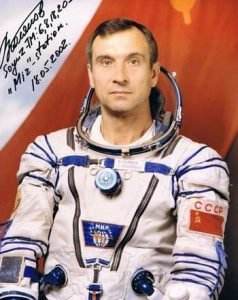 Russian former cosmonaut. He is the holder of the record for the longest single stay in space in human history, staying aboard the Mir space station for more than 14 months (437 days 18 hours) during one trip. His combined space experience is more than 22 months. he also then held the cumulative space endurance record of 679 days. He left space service on 1 Jun 1995. His education included astronautics medicine. On 22 Mar 1972 he was selected as a biomedical specialist cosmonaut for a planned space station mission and began training in Oct 1972. Polyakov made his first flight into space aboard Soyuz TM-6 in 1988. He returned to Earth 240 days later aboard TM-7. Polyakov completed his second flight into space in 1994–1995, spending 437 days in space between launching on Soyuz TM-18 and landing on TM-20, setting the record for the longest time continuously spent in space by an individual in human history.
Russian former cosmonaut. He is the holder of the record for the longest single stay in space in human history, staying aboard the Mir space station for more than 14 months (437 days 18 hours) during one trip. His combined space experience is more than 22 months. he also then held the cumulative space endurance record of 679 days. He left space service on 1 Jun 1995. His education included astronautics medicine. On 22 Mar 1972 he was selected as a biomedical specialist cosmonaut for a planned space station mission and began training in Oct 1972. Polyakov made his first flight into space aboard Soyuz TM-6 in 1988. He returned to Earth 240 days later aboard TM-7. Polyakov completed his second flight into space in 1994–1995, spending 437 days in space between launching on Soyuz TM-18 and landing on TM-20, setting the record for the longest time continuously spent in space by an individual in human history.
વલેરી વલાદિમીરોવિચ પોલિકોવ (૨૭ એપ્રિલ ૧૯૪૨):-
તેઓ રશિયન ભૂતપૂર્વ કોસ્મોન્ટ છે. તેઓ માનવ ઇતિહાસમાં અવકાશમાં સૌથી વધુ સમય એકલા રહેવા માટેનો રેકોર્ડ ધરાવે છે, એક સફર દરમિયાન તેઓ 14 મહિના (437 દિવસ 18 કલાક) કરતાં વધુ સમય માટે મીર સ્પેસ સ્ટેશન પર રહ્યા હતાં. તેનો સંયુક્ત રીતે અવકાશમાં રહેવાનો અનુભવ 22 મહિનાથી વધુ છે. તેઓ 679 દિવસ અવકાશમાં રહેવાનો રેકોર્ડ પણ ધરાવે છે. તેમણે 1 જૂન 1995 ના રોજ અવકાશ સેવા છોડી દીધી હતી. તેમના શિક્ષણમાં અવકાશયાત્રીની દવાઓનો સમાવેશ થાય છે. 22 માર્ચ 1972 ના રોજ તેમને આયોજિત સ્પેસ સ્ટેશન મિશન માટે બાયોમેડિકલ નિષ્ણાત કોસ્મોન્ટ તરીકે પસંદ કરવામાં આવ્યા હતાં અને ઓક્ટોબર 1972 માં તાલીમ શરૂ કરી હતી. પોલિકોવે 1988 માં સોયુઝ TM-6 દ્વારા અવકાશમાં તેની પ્રથમ ઉડાન કરી હતી. તે TM-7 દ્વારા 240 દિવસ પછી પૃથ્વી પર પાછા ફર્યા હતાં. પોલિકોવે 1994–1995 માં અવકાશમાં બીજી ઉડાન પૂર્ણ કરી હતી, જેમાં સોયુઝ TM-18 દ્વારા અવકાશમાં લોન્ચિંગ અને TM-20 દ્વારા પરત આવ્યા હતાં જે દરમ્યાન અવકાશમાં 437 દિવસ ગાળ્યા હતાં, તેમણે માનવ ઇતિહાસમાં કોઈ વ્યક્તિ દ્વારા અવકાશમાં સતત આટલા લાંબા સમય સુધીનો રહેવાનો રેકોર્ડ બનાવ્યો હતો.
Today’s temperature:-36℃
Sunrise:-6:12 am
Sunset:-7:06 pm
Length of the day:-12h 53m
Hertha Marks Ayrton (28th april 1854):-
Hertha Marks Ayrton was an English electrical engineer, inventor and mathematician who dur ing her education showed an aptitude for science and mathematics. She invented a sphygmograph (a device that charts pulse beats, but was not the first to do so), and a line divider (a drafting instrument to divide a line into any given number of equal parts). Her design improvements made arc lights quieter and more reliable. She published a book on The Electric Arc (1902). As a woman she was denied a degree from Cambridge, and at first refused membership in the Royal Society (1902). She invented an anti-gas fan (flapper) used during WWI.
ing her education showed an aptitude for science and mathematics. She invented a sphygmograph (a device that charts pulse beats, but was not the first to do so), and a line divider (a drafting instrument to divide a line into any given number of equal parts). Her design improvements made arc lights quieter and more reliable. She published a book on The Electric Arc (1902). As a woman she was denied a degree from Cambridge, and at first refused membership in the Royal Society (1902). She invented an anti-gas fan (flapper) used during WWI.
હેર્થા માર્ક્સ આર્ટન (૨૮ એપ્રિલ ૧૮૫૪):-
હેર્થા માર્ક્સ આર્ટન એ એક ઇંગ્લિશ ઇલેક્ટ્રિકલ એન્જિનિયર, શોધક અને ગણિતશાસ્ત્રી હતાં જેમણે તેમના શિક્ષણ દરમ્યાન વિજ્ઞાન અને ગણિત પ્રત્યેની તેમની યોગ્યતા દર્શાવી હતી. તેમણે સ્ફિગમોગ્રાફ (એક ઉપકરણ કે જે પલ્સ બીટ્સને ચાર્ટ સ્વરૂપે દર્શાવે છે, પરંતુ તેઓ પ્રથમ ન હતાં), અને લાઇન ડિવાઇડર (કોઈ પણ સમાન ભાગોની સંખ્યામાં રેખાને વિભાજીત કરવા માટેનું સાધન) ની શોધ કરી. તેમણે આર્ક લાઇટ્સની ડિઝાઇનમાં સુધારા કરી વધુ સારા બનાવ્યા. તેમણે ઇલેક્ટ્રિક આર્ક (1902) પર એક પુસ્તક પ્રકાશિત કર્યું. એક સ્ત્રી તરીકે તેમણે કેમ્બ્રિજની ડિગ્રી નકારી હતી, અને રોયલ સોસાયટી (1902) માં સભ્યપદનો પણ ઇનકાર કર્યો હતો. તેણીએ વિશ્વયુદ્ધ-૧ દરમ્યાન ઉપયોગમાં લેવાયેલા એન્ટી ગેસ ફેન (ફ્લેપર) ની શોધ કરી.
Today’s temperature:-35℃
Sunrise:-6:11 am
Sunset:-7:06 pm
Length of the day:-12h 55m
Marietta Blau (29th April 1894):-
Austrian nuclear physicist who began as a strong student in mathematics and physics at school, and stud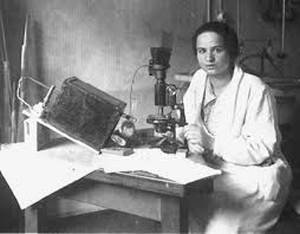 ied physics at university, where she wrote her thesis on the absorption of gamma rays (1919). At first, she took a job (1921) with a manufacturer of x-ray tubes in Berlin. By 1923, she progressed to researching radioactivity in Vienna. There she developed the photographic emulsion technique for the study of nuclear disintegration caused by cosmic rays, and contributed to development of photomultiplier tubes. Blau was first to use nuclear emulsions to detect neutrons by observing recoil protons. Albert Einstein recognized her as a very capable experimental physicist.
ied physics at university, where she wrote her thesis on the absorption of gamma rays (1919). At first, she took a job (1921) with a manufacturer of x-ray tubes in Berlin. By 1923, she progressed to researching radioactivity in Vienna. There she developed the photographic emulsion technique for the study of nuclear disintegration caused by cosmic rays, and contributed to development of photomultiplier tubes. Blau was first to use nuclear emulsions to detect neutrons by observing recoil protons. Albert Einstein recognized her as a very capable experimental physicist.
મેરિએટા બ્લાઉ (૨૯ એપ્રિલ ૧૮૯૪):-
તેઓ ઓસ્ટ્રેલિયન પરમાણુ ભૌતિકશાસ્ત્રી હતાં જેમણે શાળામાં ગણિત અને ભૌતિકશાસ્ત્રનાં શ્રેષ્ઠ વિદ્યાર્થી તરીકે પ્રારંભ કર્યો હતો, અને યુનિવર્સિટીમાં ભૌતિકશાસ્ત્રનો અભ્યાસ કર્યો હતો, જ્યાં તેમણે ગામા કિરણોનાં શોષણ પર તેમનું થિસીસ(1919) લખ્યું હતું. શરૂઆતમાં, તેમણે બર્લિનમાં એક્સ-રે ટ્યુબનાં ઉત્પાદક તરીકે નોકરી (1921) મેળવી. 1923માં, તેમણે વિયેનામાં રેડિયોએક્ટિવિટી પર સંશોધન કાર્ય શરૂ કર્યું. ત્યાં તેમણે કોસ્મિક કિરણોને લીધે થતાં પરમાણુ વિઘટનના અભ્યાસ માટે ફોટોગ્રાફિક ઇમલ્શન ટેકનીક વિકસાવી, અને ફોટોમોલ્ટિપ્લાયર ટ્યુબનાં વિકાસમાં ફાળો આપ્યો. રિકોઇલ પ્રોટોનનું અવલોકન કરીને ન્યુટ્રોનને શોધવા માટે બ્લાઉએ સૌપ્રથમ પરમાણુ પ્રવાહીનો ઉપયોગ કર્યો હતો. આલ્બર્ટ આઈન્સ્ટાઈ ને તેમને ખૂબ સક્ષમ પ્રાયોગિક ભૌતિકશાસ્ત્રી તરીકે નામના આપી હતી.
Today’s temperature:-35℃
Sunrise:-6:11 am
Sunset:-7:07 pm
Length of the day:-12h 56m
George Robert Stibitz (30th April 1904):-
U.S. mathematician who was regarded by many as the “father of the modern digital computer.” While serving as a research mathematician at Bell Telephone Laboratories in New York City, Stibitz worked on relay switching equipment used in telephone networks. In 1937, Stibitz, a 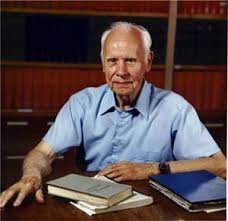 scientist at Bell Laboratories built a digital machine based on relays (electrically operated switch), flashlight bulbs, and metal strips cut from tin-cans. He called it the “Model K” because most of it was constructed on his kitchen table. It worked on the principle that if two relays were activated they caused a third relay to become active, where this third relay represented the sum of the operation. Also, in 1940, he gave a demonstration of the first remote operation of a computer.
scientist at Bell Laboratories built a digital machine based on relays (electrically operated switch), flashlight bulbs, and metal strips cut from tin-cans. He called it the “Model K” because most of it was constructed on his kitchen table. It worked on the principle that if two relays were activated they caused a third relay to become active, where this third relay represented the sum of the operation. Also, in 1940, he gave a demonstration of the first remote operation of a computer.
જ્યોર્જ રોબર્ટ સ્ટીબિટ્ઝ (૩૦ એપ્રિલ ૧૯૦૪):-
તેઓ યુ.એસ.ના ગણિતશાસ્ત્રી હતાં જેને ઘણા લોકો “આધુનિક ડિજિટલ કમ્પ્યુટરના પિતા” તરીકે માને છે. ન્યુ યોર્ક સિટીમાં બેલ ટેલિફોન લેબોરેટરીઝમાં સંશોધન ગણિતશાસ્ત્રી તરીકે સેવા આપતી વખતે, સ્ટીબિટ્ઝે ટેલિફોન નેટવર્કમાં ઉપયોગમાં લેવાતા રિલે સ્વિચિંગ સાધનો પર કામ કર્યું. 1937 માં, બેલ લેબોરેટરીઝના વૈજ્ઞાનિક સ્ટીબિટ્ઝે રિલે (ઇલેક્ટ્રિકલી ઓપરેટેડ સ્વિચ), ફ્લેશલાઇટ બલ્બ અને ટીન-કેનમાંથી કાપેલઈ ધાતુની પટ્ટીનાં આધારે ડિજિટલ મશીન બનાવ્યું. તેણે તેને “મોડેલ કે” તરીકે ઓળખાવ્યો કારણ કે તેમાંની મોટાભાગની વસ્તુ તેના રસોડામાંથી લેવામાં આવી હતી. જો બે રિલે સક્રિય હોય, તો તે ત્રીજા રિલેને સક્રિય બનાવે છે, આ સિદ્ધાંત પર તેમણે કામ કર્યું હતું કે, જ્યાં આ ત્રીજો રિલે આખા કાર્યનો સરવાળો રજૂ કરે છે. ઉપરાંત, 1940માં, તેણે કમ્પ્યુટરનાં પ્રથમ રિમોટ ઓપરેશનનું પ્રદર્શન કર્યું હતું.






Very useful information…
I really appreciate your work…
Very good information… keep sharing knowledge…
clean and exact! thank you for sharing the information
It s superb very nice good Information
Very useful information keep posting such important things
Good Work keep it up??
good information about day , enjoyed thanks
આ સરસ માહતી છે. રોજની વિજ્ઞાન વાતો જાણવા મળશે. હું મારા મિત્રો ને આ વાત કહીશ.
આ સરળ માહિતી વિદ્યાર્થીઓને ખૂબ જ ઉપયોગી.હૂ વિધાર્થી ને સ્કૂલ માં કહીશ
So nice of you! I will too!
thank you